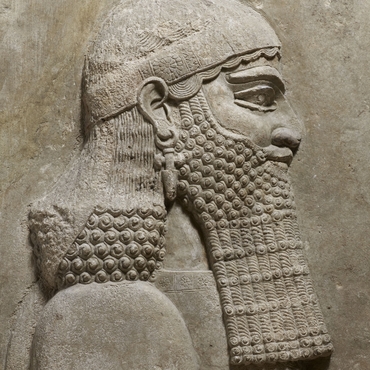
- Home
- The luxury of an Assyrian palace
- The king and his court
Royal pagentry
The Assyrian king is recognisable by his royal headdress - a truncated conical tiara with a pointed top. He is dressed in embroidered clothes and adorned with jewellery. He often carries a sword at his side and sometimes a cane - a symbol of power. In some scenes, he shelters under a parasol surrounded by servants waving fly-whisks. He sometimes holds a fan or flowers in his hand. When hunting or fighting, he is depicted in a two-wheeled chariot drawn by elaborately harnessed horses.
Dignitaries and eunuchs
Crown Prince Sennacherib, and Sinahusur, the king's brother and grand vizier, are among the high dignitaries. Other lower-ranking dignitaries nevertheless feature among the privileged members of the court and are recognisable by their luxurious dress. The reliefs also depict eunuchs, who are recognisable by their lack of facial hair. They were a privileged class of servants and could hold high civil and military offices.
Wives and princesses
Women are largely absent from Assyrian depictions, although female prisoners do feature in deportation scenes. Royal wives and princesses feature heavily in correspondence, however, since they played an important role in cementing political alliances and Sargon married one of his daughters to the King of Tabal. A bronze relief from the Louvre shows Esarhaddon, grandson of Sargon, with his mother Naqi’a. The wife of Ashurbanipal, son of Esarhaddon, is depicted banqueting with her husband on a Nineveh relief conserved in the British Museum.






